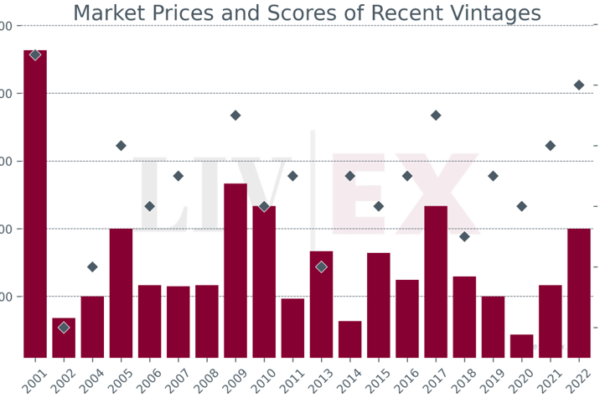Guest blog from Gavin Quinney
With the Bordeaux crop now safely in barrel, rumour has it that 2010 may be another great vintage. Here, Liv-ex is opening up the blog to Gavin Quinney (@GavinQuinney), a local grower and winemaker, for an insider's view on 2010. Gavin is an experienced taster and has covered the Primeurs for Wine & Spirit magazine – and latterly, Harpers Wine & Spirit Trades Review – since the 2005 vintage. Today's report will focus on the weather in 2010, whilst next week's follow-up report will cover the wines.
—
As wine merchants and critics make their travel arrangements for the En Primeur barrel tastings in late March and early April, here are some early conclusions that can be drawn about 2010 – with the help of a few weather charts.
As a grower in Bordeaux – and being British - the weather is something I keep an eye on. I also visited scores of leading chateaux during the growing season and throughout the harvest.
In summary:
- 2010 was a very dry year.
- 2010 was sunny…
- …but not too hot.
- Uneven flowering, lower yields?
- Top terroirs shine, again.
- Rain in the nick of time.
- A later harvest (than 2009 and 2005).
- Harvest ‘à la carte’.
2010 was a very dry year

I live 15 miles east of Bordeaux and 15 miles south-west of St-Emilion, between the Garonne and Dordogne rivers. Bordeaux is a vast wine region and the weather can vary significantly from one end to the other. It’s fair to say, though, that 2010 was a dry year across all areas.

Throughout the growing season, from April to October, we had less than half the rainfall than in 2009 – itself a dry year. 2010 was an exceptionally dry year, and not just at the business end of the season from June through to the harvest. There was less rain in March compared to the average, then very low rainfall in April and May, leaving a shortage of water reserves before the summer had even begun.
2010 was sunny…

2010 saw a fairly similar return to 2009 and 2005 from July to September (when the fruit ripens) and the sunshine continued into October, which was when most of the top reds were picked. Note the differences between these great years and other recent vintages – differences which are reflected in the wines.
But not too hot

There was plenty of sunshine in 2010 but it wasn’t particularly hot which, given the near drought conditions, was a relief. May was much cooler than the 30-year average (14.2˚C v 15.4˚C), June warmer (18.6˚C v 18.3˚C), and July warmer still (21.7˚C v 21˚C), while August was a shade cooler (20˚C v 21˚C), as was September.
It’s been said that Bordeaux will become too hot for Merlot and Cabernet with the changing climate. These graphs seem to show that it’s not rising temperatures, but a shortage of rainfall that could be more of a concern for the vast majority of growers that don’t have perfect terroirs.
Late start, then uneven flowering
The graphs above tell half the story. To have a better feeling for how the weather affects the vines, some day-to-day tracking can be helpful. March was cold, with much colder soils than normal until the 20th of March, leading to a later budburst than usual in April.

A sunny April, then a hot streak in late May, followed by a cold snap, probably confused the vines. Rain in the first half of June didn’t help at this critical time, so the flowering was mixed. The Merlot, which is more vulnerable to poor fruit set, was inconsistent from one parcel to another, and often from one vine to another – a result of coulure and millerandage. This was evident on both banks. Old timers also said that as there were many larger bunches, the flowering was poor – ‘the bigger the bunches the lower the yield’.
Many of the top estates saw lower yields through a combination of poor flowering and uneven fruit set; fewer bunches; green harvesting later on; strict selection; smaller berries; and less juice from the very dry weather. But I saw many vineyards, often in the so-called lesser appellations, positively groaning with bunches, so general claims of low yields might be misleading.
Top terroirs shine, again

After rain in mid-June, it was a dry old time in the vines throughout the summer. By the end of August, there were clear signs of stress in many vineyards through lack of water. Merlot leaves in many parcels from Margaux to Pomerol were wilting, and younger vines suffered.
The great terroirs showed extraordinary resilience to the drought conditions by providing just enough sustenance to the vines. Some of the Cabernet Sauvignon on the gravelly knolls at Lafite and Mouton and other top sites in Pauillac, St-Julien and St-Estephe looked extraordinarily healthy – as did Merlot on the best clay-limestone terroirs around St-Emilion and Castillon. The Cabernet Franc at Cheval Blanc and Angélus also looked in perfect shape.
Rain in the nick of time

Light rain in early September provided welcome moisture (the ‘before and after’ effect on the leaves in vineyards like Le Pin was clear) and further showers around the 24th and the 29th had a positive effect, as did quite heavy rain on the 4th of October. In between, and on into mid-October, it was clear and sunny.
Too much rain, coupled with a later harvest, and there’s a risk of rot. But the weather held and I saw no rot whatsoever on any red grapes until mid-October (and those were mine).
A later harvest (than 2009 and 2005)
The later budburst at the start of the season was reflected in the later harvest dates than 2009 – some four to ten days - despite the very dry, sunny summer. Later and greater don’t normally go hand in hand, but 2010 is an exception.
Harvest ‘à la carte’
Pierre Lurton claimed at Yquem on the 28th of September that it was another harvest during which chateaux could pick when they wanted to, or ‘à la carte’. I was somewhat sceptical, given that the red harvest had only just begun. Nine days later, they were cheerily picking Cabernet Franc in bright sunshine at Cheval Blanc in St-Emilion (which he also manages). The week after that, they were leisurely picking Cabernet Sauvignon at Margaux, Lafite and Mouton – again in bright sunshine. Back on the Right Bank, they were still bringing in the Merlot, in lovely condition, at Troplong Mondot on the 15th of October.
I have to admit, Monsieur Lurton might just have been right.



